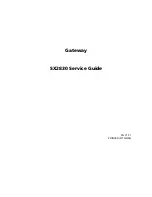
PROFIBUS INTERFACE
49
5
We will assume for this example that both the Input and Output Buffers have been configured
to 32 bytes each. This means that the controllers response (for this command) can fit entirely
in the input buffer, and no fragmentation is required.
Sending the command:
In
Byte 2
of the output buffer the Master places the length (in bytes) of the data packet (CBx
Command) we are sending. In this case the CBx command we are sending is 12 bytes. This
length is the length of the command bytes we are interested in sending, not the full size of
the buffer. The length also does not include the “Data Consistency Byte” at the end of the
buffer. That is just a mirror of the Control Byte.
In Byte 3
through
Byte 14
the Master places the 12 bytes of this particular CBx command.
Some CBx commands are larger, but all will be at least 12 bytes, even if some of those 12
bytes are not actually used.
(See the
Green
changes below)
Output Buffer
Input Buffer
Byte # Value
Byte # Value
00:
80
Output Buffer Control Byte
(OBCB)
7 6 5 4 3 2 1 0
[1] [0] [0] [0] [0] [0] [0] [0]
00
80
Input Buffer Control Byte
(IBCB)
7 6 5 4 3 2 1 0
[1] [0] [0] [0] [0] [0] [0] [0]
01: 00 (Always
0)
01: 00
02:
0C
(Packet length in bytes)
02: 00
03:
04:
05:
06:
07:
08:
09:
10:
11:
12:
13:
14:
15:
16:
17:
18:
19:
20:
..
30:
00
06
AA
07
00
01
03
E8
00
00
00
00
00
00
00
00
00
00
..
00
(CBx Command word length MSB)
(CBx Command word length LSB)
Minimum of 6 words
(CBx Command Type)
Always AA
(CBx Command Opcode)
0x07 = Read Tag ID
(CBx Command, byte not used)
(CBx Command “Node ID”)
(CBx Command Timeout MSB)
(CBx Command Timeout LSB)
0xE8 = 1000 ms timeout
(CBx Command Not Used)
(CBx Command Not Used)
(CBx Command Not Used)
(CBx Command Not Used)
03:
04:
05:
06:
07:
08:
09:
10:
11:
12:
13:
14:
15:
16:
17:
18:
19:
20:
..
30:
00
00
00
00
00
00
00
00
00
00
00
00
00
00
00
00
00
00
..
00
31: 80
Data Consistency Byte (OBDCB)
31: 80
Data Consistency Byte (IBDCB)
Now that the command is in the Output Buffer, The Master alerts the Slave that the
command is ready. It does this by toggling
Bit 1
of the
Output Buffer Control Byte
(the
OBCB
) and then also toggling the same bit in the
Output Buffer Data Consistence Byte
(the
OBDCB
).
NOTE
This bit is a toggle. So if it is 0, it is toggled to 1 to indicate a new command.
If it is 1, it is toggled to 0 to indicate a new command. If the bit is 1, setting it
to 0, and then back to 1 will cause the command to be issued twice.
Содержание GWY-01-PBS-01
Страница 1: ...GWY 01 PBS 01 Reference Manual ...
Страница 5: ...v C ASCII CHART 92 ...
Страница 101: ...www automation datalogic com ...
















































